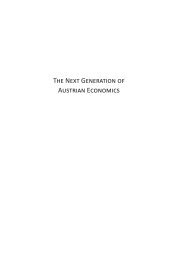capitalist_and_entrepreneur_klein
capitalist_and_entrepreneur_klein
capitalist_and_entrepreneur_klein
You also want an ePaper? Increase the reach of your titles
YUMPU automatically turns print PDFs into web optimized ePapers that Google loves.
26 <br />
different from the other factors. In an ownership approach, money capital<br />
is treated as a unique factor of production, the “controlling factor”; the<br />
investor is both ultimate decision-maker <strong>and</strong> residual claimant. e firm’s<br />
objective is to maximize the return on the owner’s investment. Because<br />
the owner delegates certain functions to managers, a central focus of the<br />
theory of the firm becomes the problem of corporate governance: how do<br />
suppliers of capital structure their arrangements with managers in a way<br />
that maximizes their returns?<br />
is chapter argues that the most interesting problems in the theory<br />
of the firm relate to the intersection between the <strong>entrepreneur</strong>ial function<br />
<strong>and</strong> the <strong>capitalist</strong> function. Indeed, as Mises argued, the driving<br />
force behind the market economy is a particular type of <strong>entrepreneur</strong>,<br />
the <strong>capitalist</strong>-<strong>entrepreneur</strong>, who risks his money capital in anticipation of<br />
future, uncertain, returns. Moreover, as discussed below, the <strong>entrepreneur</strong><br />
is nearly always also a <strong>capitalist</strong>, <strong>and</strong> the <strong>capitalist</strong> is also an <strong>entrepreneur</strong>.<br />
Economists now increasingly recognize the importance of the <strong>capitalist</strong><br />
in the direction of the firm’s affairs. In the introduction to his influential<br />
book Strong Managers, Weak Owners, Mark Roe (1994, p. vii) makes the<br />
point succinctly:<br />
Economic theory once treated the firm as a collection of machinery,<br />
technology, inventory, workers, <strong>and</strong> capital. Dump these inputs<br />
into a black box, stir them up, <strong>and</strong> one got outputs of products<br />
<strong>and</strong> profits. Today, theory sees the firm as more, as a management<br />
structure. e firm succeeds if managers can successfully coordinate<br />
the firm’s activities; it fails if managers cannot effectively<br />
coordinate <strong>and</strong> match people <strong>and</strong> inputs to current technologies<br />
<strong>and</strong> markets. At the very top of the firm are the relationships among<br />
the firm’s shareholders, its directors, <strong>and</strong> its senior managers. If<br />
those relationships are dysfunctional, the firm is more likely to<br />
stumble.<br />
As Roe suggests, the relationships between the firm’s owners (shareholders)<br />
<strong>and</strong> its top managers are centrally important in determining firm performance.<br />
3<br />
3 For surveys of the literature on corporate governance see Gilson (1996); Shleifer <strong>and</strong><br />
Vishny (1997) <strong>and</strong> Zingales (1998).








